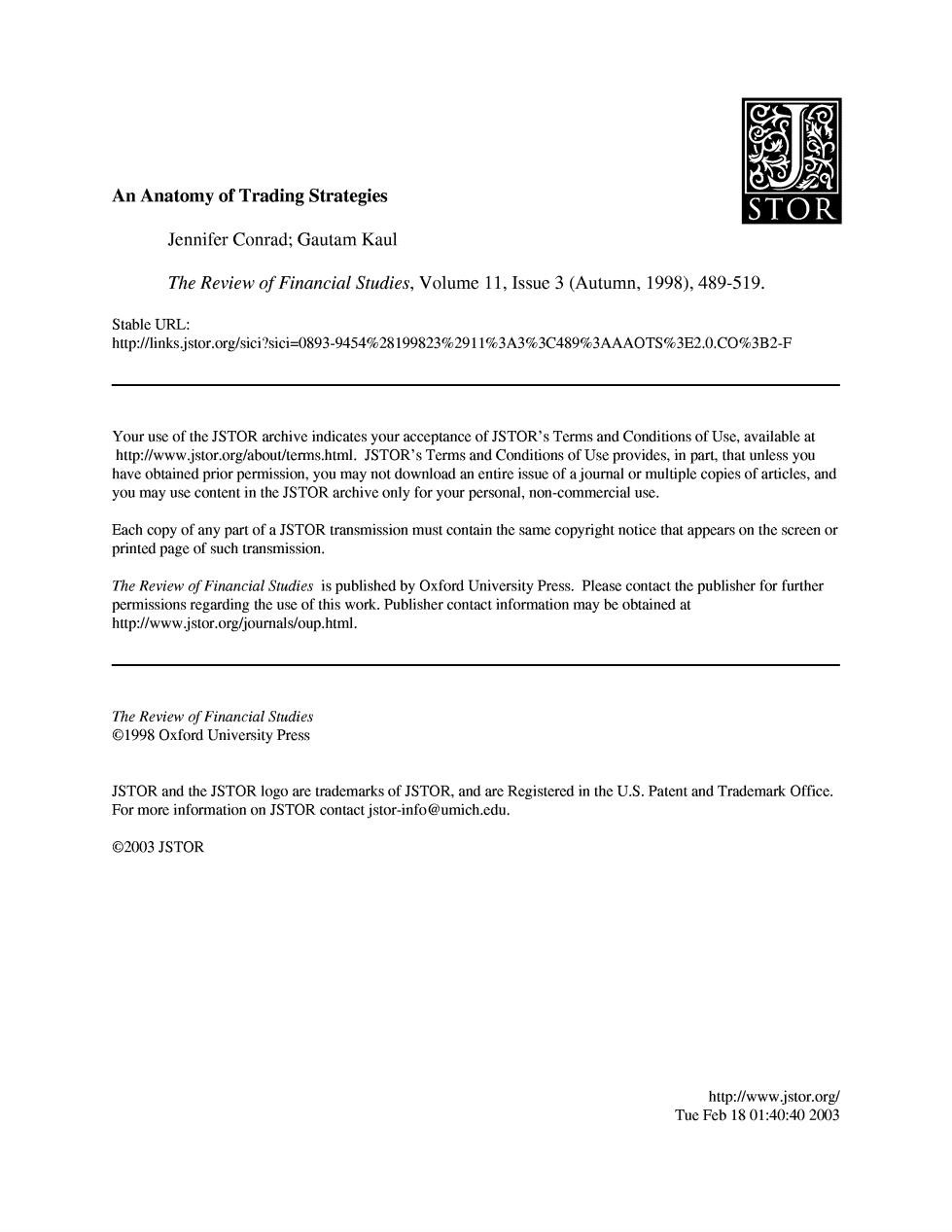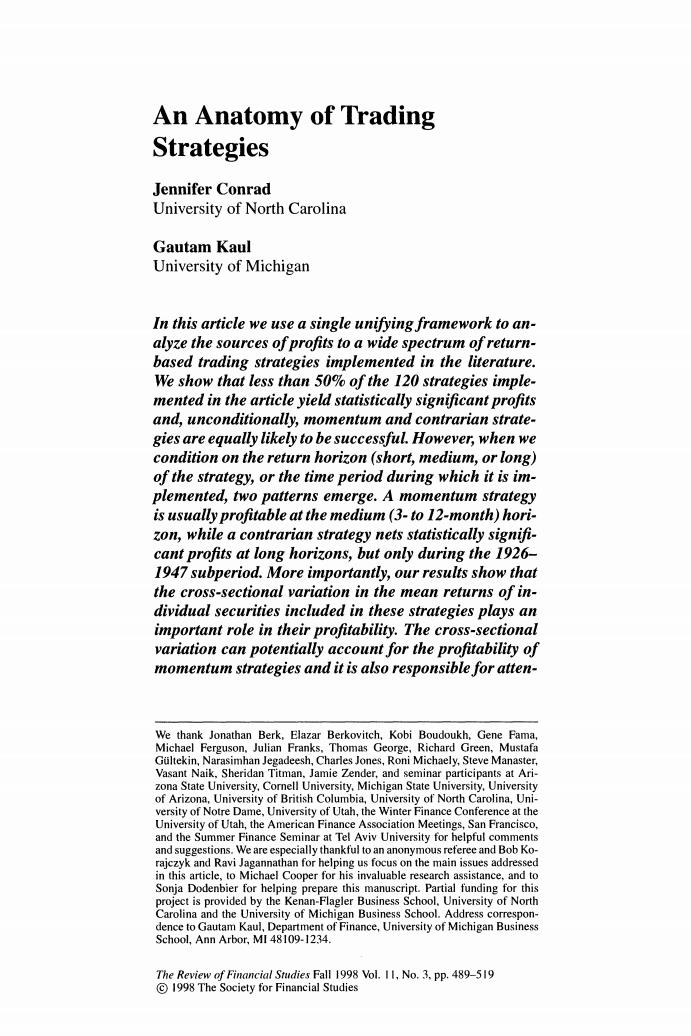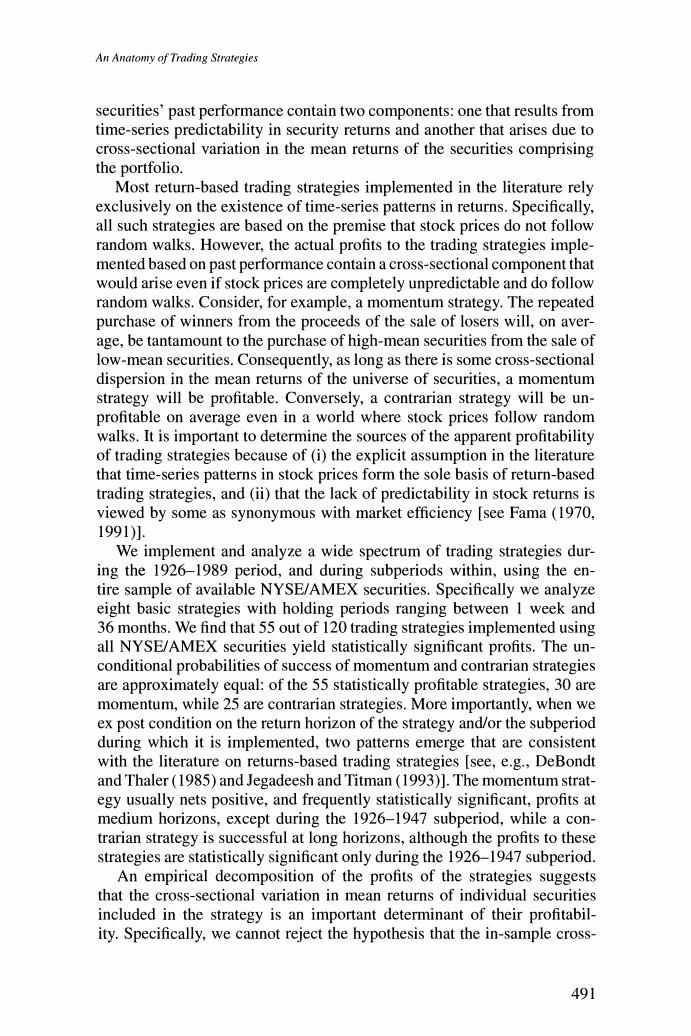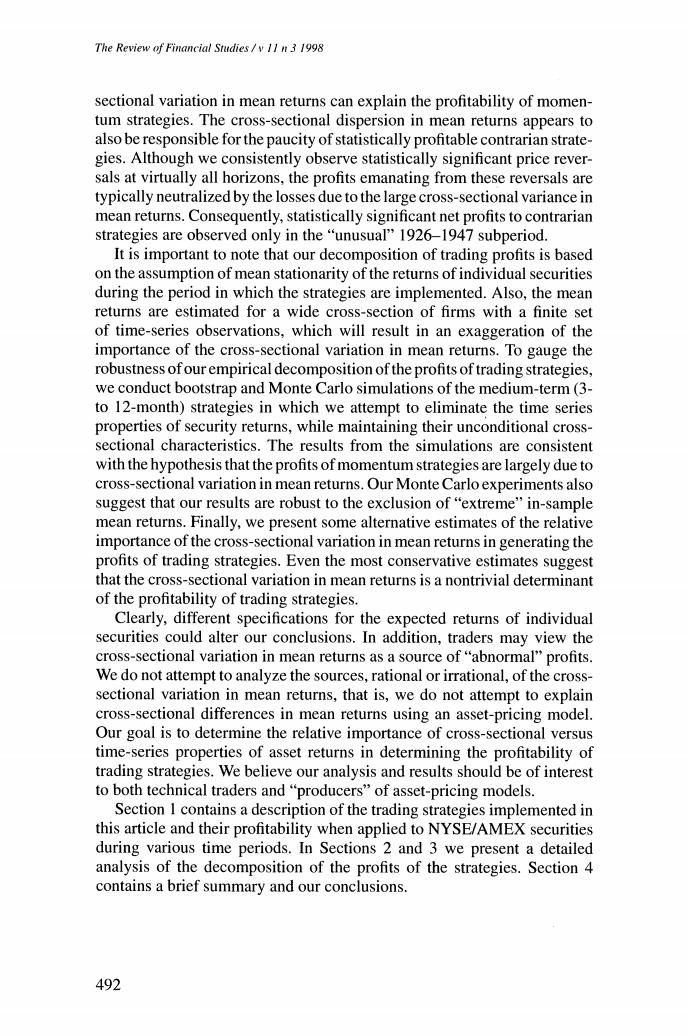
An Anatomy of Trading Strategies STOR Jennifer Conrad;Gautam Kaul The Review of Financial Studies,Volume 11,Issue 3 (Autumn,1998),489-519. Stable URL: http://links.istor.org/sici?sici=0893-9454%28199823%2911%3A3%3C489%3AAAOTS3E2.0.CO%3B2-F Your use of the JSTOR archive indicates your acceptance of JSTOR's Terms and Conditions of Use,available at http://www.jstor.org/about/terms.html.JSTOR's Terms and Conditions of Use provides,in part,that unless you have obtained prior permission,you may not download an entire issue of a journal or multiple copies of articles,and you may use content in the JSTOR archive only for your personal,non-commercial use. Each copy of any part of a JSTOR transmission must contain the same copyright notice that appears on the screen or printed page of such transmission. The Review of Financial Studies is published by Oxford University Press.Please contact the publisher for further permissions regarding the use of this work.Publisher contact information may be obtained at http://www.jstor.org/journals/oup.html. The Review of Financial Studies 1998 Oxford University Press JSTOR and the JSTOR logo are trademarks of JSTOR,and are Registered in the U.S.Patent and Trademark Office. For more information on JSTOR contact jstor-info@umich.edu. ©2003 JSTOR http://www.jstor.org/ Tue Feb1801:40:402003

An Anatomy of Trading Strategies Jennifer Conrad University of North Carolina Gautam Kaul University of Michigan In this article we use a single unifying framework to an- alyze the sources of profits to a wide spectrum of return- based trading strategies implemented in the literature. We show that less than 50%of the 120 strategies imple- mented in the article yield statistically significant profits and,unconditionally,momentum and contrarian strate- gies are equally likely to be successful.However,when we condition on the return horizon(short,medium,or long) of the strategy,or the time period during which it is im- plemented,two patterns emerge.A momentum strategy is usually profitable at the medium(3-to 12-month)hori- zon,while a contrarian strategy nets statistically signifi- cant profits at long horizons,but only during the 1926- 1947 subperiod.More importantly,our results show that the cross-sectional variation in the mean returns of in- dividual securities included in these strategies plays an important role in their profitability.The cross-sectional variation can potentially account for the profitability of momentum strategies and it is also responsible for atten- We thank Jonathan Berk,Elazar Berkovitch,Kobi Boudoukh.Gene Fama, Michael Ferguson.Julian Franks.Thomas George,Richard Green,Mustafa Gultekin,Narasimhan Jegadeesh,Charles Jones,Roni Michaely,Steve Manaster, Vasant Naik,Sheridan Titman,Jamie Zender,and seminar participants at Ari- zona State University,Cornell University.Michigan State University,University of Arizona,University of British Columbia,University of North Carolina,Uni- versity of Notre Dame,University of Utah,the Winter Finance Conference at the University of Utah,the American Finance Association Meetings,San Francisco, and the Summer Finance Seminar at Tel Aviv University for helpful comments and suggestions.We are especially thankful to an anonymous referee and Bob Ko- rajezyk and Ravi Jagannathan for helping us focus on the main issues addressed in this article,to Michael Cooper for his invaluable research assistance,and to Sonja Dodenbier for helping prepare this manuscript.Partial funding for this project is provided by the Kenan-Flagler Business School.University of North Carolina and the University of Michigan Business School.Address correspon- dence to Gautam Kaul,Department of Finance,University of Michigan Business School,Ann Arbor,MI 48109-1234. The Review of Financial Studies Fall 1998 Vol.I1,No.3.pp.489-519 C 1998 The Society for Financial Studies

The Review of Financial Studies /v 11 n 3 1998 uating the profits from price reversals to long-horizon contrarian strate- gies. Trading strategies that apparently"beat the market"date back to the incep- tion of trading in financial assets.A number of practitioners and academics in the pre-market-efficiency era (i.e.,pre-1960s)believed that predictable patterns in stock returns could lead to"abnormal"profits to trading strate- gies.In fact,Keynes(1936)succinctly summarized the views of many by stating that most investors'decisions"can be taken only as a result of animal spirits...."In recent years there has been a dramatic resurgence of academic interest in the predictability of asset returns based on their past history.More significantly,a growing number of researchers argue that time-series pat- terns in returns are due to market inefficiencies and can,consequently,be consistently translated into"abnormal"profits. Broadly speaking,these articles analyze two strategies,diametrically opposed in philosophy and execution:the contrarian strategy that relies on price reversals and the momentum strategy based on price continuations (or"momentum"in asset prices).Until recently there has been relatively more emphasis on contrarian strategies,but there is growing evidence that price continuations result in consistent "abnormal"profits to momentum strategies.One of the most perplexing aspects of this literature is that these two diametrically opposed strategies appear to"work"simultaneously,al- beit for different investment horizons.Specifically,contrarian strategies are apparently profitable for the short-term (weekly,monthly)and long-term (3-to 5-year,or longer)intervals,while the momentum strategy is profitable for medium-term (3-to 12-month)holding periods. In this article we attempt to determine the sources of the expected prof- its of the entire class of trading strategies that are based on information contained in past returns of individual securities.The strength of our anal- ysis is that we use a single framework,which builds on the analyses in Lehmann (1990)and Lo and MacKinlay (1990),to decompose the profits of all strategies,contrarian or momentum and short term to long term.This decomposition is important because profits to trading strategies based on For earlier analyses of patterns in security returns,and/or trading strategies based on these patters,see among others,Alexander (1961,1964),Cootner (1964),Fama (1965.1970),Fama and Blume (1966), Levy (1967),Van Horne and Parker (1967),James (1968),and Jensen and Bennington (1970). A few of the numerous recent articles that deal with retum predictability are Conrad and Kaul (1988 1989).Fama and French(1988).Lo and MacKinlay (1988),Porterba and Summers (1988).Campbell, Grossman,and Wang(1993),Richardson(1993),Boudoukh,Richardson,and Whitelaw (1994),Conrad, Hameed,and Niden (1994),and Jones (1994).And notable among recent articles that document the apparent profitability of trading strategies based on such predictability are DeBondt and Thaler(1985). Chan (1988).Sweeney (1988).Jegadeesh (1990).Lehmann (1990).Lo and MacKinlay (1990).Levich and Thomas (1991).Brock,Lakonishok,and LeBaron (1992).Chopra,Lakonishok and Ritter(1992), Allen and Karjalainen (1993),Jegadeesh and Titman (1993,1995a),and Asness (1994).Kaul (1997) provides a review of the empirical methodologies used to uncover return predictability. 490

An Anatomy of Trading Strategies securities'past performance contain two components:one that results from time-series predictability in security returns and another that arises due to cross-sectional variation in the mean returns of the securities comprising the portfolio. Most return-based trading strategies implemented in the literature rely exclusively on the existence of time-series patterns in returns.Specifically, all such strategies are based on the premise that stock prices do not follow random walks.However,the actual profits to the trading strategies imple- mented based on past performance contain a cross-sectional component that would arise even if stock prices are completely unpredictable and do follow random walks.Consider,for example,a momentum strategy.The repeated purchase of winners from the proceeds of the sale of losers will,on aver- age,be tantamount to the purchase of high-mean securities from the sale of low-mean securities.Consequently,as long as there is some cross-sectional dispersion in the mean returns of the universe of securities,a momentum strategy will be profitable.Conversely,a contrarian strategy will be un- profitable on average even in a world where stock prices follow random walks.It is important to determine the sources of the apparent profitability of trading strategies because of (i)the explicit assumption in the literature that time-series patterns in stock prices form the sole basis of return-based trading strategies,and (ii)that the lack of predictability in stock returns is viewed by some as synonymous with market efficiency [see Fama(1970, 1991)] We implement and analyze a wide spectrum of trading strategies dur- ing the 1926-1989 period,and during subperiods within,using the en- tire sample of available NYSE/AMEX securities.Specifically we analyze eight basic strategies with holding periods ranging between I week and 36 months.We find that 55 out of 120 trading strategies implemented using all NYSE/AMEX securities yield statistically significant profits.The un- conditional probabilities of success of momentum and contrarian strategies are approximately equal:of the 55 statistically profitable strategies,30 are momentum,while 25 are contrarian strategies.More importantly,when we ex post condition on the return horizon of the strategy and/or the subperiod during which it is implemented,two patterns emerge that are consistent with the literature on returns-based trading strategies [see,e.g.,DeBondt and Thaler (1985)and Jegadeesh and Titman (1993)].The momentum strat- egy usually nets positive,and frequently statistically significant,profits at medium horizons,except during the 1926-1947 subperiod,while a con- trarian strategy is successful at long horizons,although the profits to these strategies are statistically significant only during the 1926-1947 subperiod. An empirical decomposition of the profits of the strategies suggests that the cross-sectional variation in mean returns of individual securities included in the strategy is an important determinant of their profitabil- ity.Specifically,we cannot reject the hypothesis that the in-sample cross- 491

The Review of Financial Studies /y 11 n 3 1998 sectional variation in mean returns can explain the profitability of momen- tum strategies.The cross-sectional dispersion in mean returns appears to also be responsible for the paucity of statistically profitable contrarian strate- gies.Although we consistently observe statistically significant price rever- sals at virtually all horizons,the profits emanating from these reversals are typically neutralized by the losses due to the large cross-sectional variance in mean returns.Consequently,statistically significant net profits to contrarian strategies are observed only in the"unusual"1926-1947 subperiod. It is important to note that our decomposition of trading profits is based on the assumption of mean stationarity of the returns of individual securities during the period in which the strategies are implemented.Also,the mean returns are estimated for a wide cross-section of firms with a finite set of time-series observations,which will result in an exaggeration of the importance of the cross-sectional variation in mean returns.To gauge the robustness of our empirical decomposition of the profits of trading strategies, we conduct bootstrap and Monte Carlo simulations of the medium-term(3- to 12-month)strategies in which we attempt to eliminate the time series properties of security returns,while maintaining their unconditional cross- sectional characteristics.The results from the simulations are consistent with the hypothesis that the profits of momentum strategies are largely due to cross-sectional variation in mean returns.Our Monte Carlo experiments also suggest that our results are robust to the exclusion of "extreme"in-sample mean returns.Finally,we present some alternative estimates of the relative importance of the cross-sectional variation in mean returns in generating the profits of trading strategies.Even the most conservative estimates suggest that the cross-sectional variation in mean returns is a nontrivial determinant of the profitability of trading strategies. Clearly,different specifications for the expected returns of individual securities could alter our conclusions.In addition,traders may view the cross-sectional variation in mean returns as a source of "abnormal"profits. We do not attempt to analyze the sources,rational or irrational,of the cross- sectional variation in mean returns,that is,we do not attempt to explain cross-sectional differences in mean returns using an asset-pricing model. Our goal is to determine the relative importance of cross-sectional versus time-series properties of asset returns in determining the profitability of trading strategies.We believe our analysis and results should be of interest to both technical traders and"producers"of asset-pricing models. Section 1 contains a description of the trading strategies implemented in this article and their profitability when applied to NYSE/AMEX securities during various time periods.In Sections 2 and 3 we present a detailed analysis of the decomposition of the profits of the strategies.Section 4 contains a brief summary and our conclusions. 492